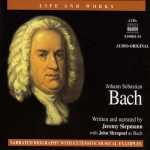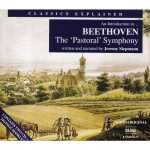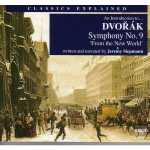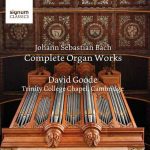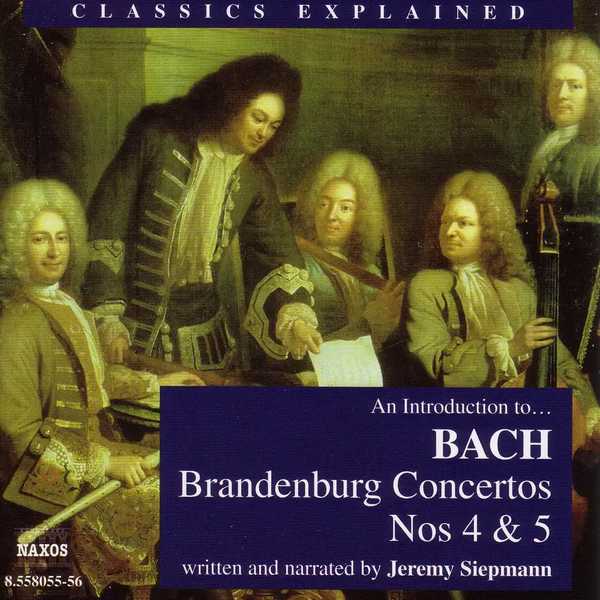
Composer: Johann Sebastian Bach
Performer: Jeremy Siepmann
Number of Discs: 2
Format: FLAC (tracks)
Label: Naxos
Catalogue: 8558055-56
Release: 2002
Size: 575 MB
Recovery: +3%
Scan: cover
CD 01
Brandenburg Concerto No. 4 in G
01. The Brandenburgs as concerti grossi
First Movement
02. Introduction. Melody, Theme and Motif; Bach’s opening gambit
03. Onwards and upwards: Motif No. 2 and its function
04. The two elements of Motif No. 2 and the effect of their combination
05. The ‘motto’ rhythm hidden even within the opening bar
06. Motif No. 3, Introduced by the two recorders, has a kind of ‘hovering’ character
07. Motif No. 3 repeated for a second, ‘directed’ listen
08. Bach reminds us of the opening
09. Motif No. 4 – A steadily rising derivative of Motif No. 1
10. Motif No. 5, A lovely, bouncy, syncopated flourish, in which all the instruments join
11. Opening Ritornello (complete)
12. Episode 1 begins with virtuoso entry of the solo violin, made up of alternating arpeggios
13. Motif No. 3 returns, courtesy of the recorders, recently sidelined by the violin
14. Ritornello 2, a varied repeat of Ritornello 1, arrives after much harmonic movement
15. Episode 2, Pt. 1, preceded by the ‘fanfare’ motif from which its first theme derives
16. Episode 2 continued, with more bravura dazzle from the solo violin
17. Repeat of section for purposes of hearing the harmonic movement
18. Ritornello 3, with the prominent participation of the soloists
19. Episode 3 proves retrospective, featuring transposed repeats of earlier material
20. Ritornello 4, not altogether what It might seem; solo violin takes ‘motto’ motif
21. Episode 4. Cue to Pt. 1, focusing on ‘soloistic’ counterpoint provided by the continuo
22. Return to Ritornello 4 to hear sources of Episode 4, Pt. 2
23. Episode 4 continued, with emphasis placed on conversational interchanges
24. Return to opening Ritornello in order to enhance awareness of the contrast
25. Ritornello 5, beginning
26. Ritornello 5 continued, with emphasis on the determined banishment of B Minor
27. Cue to complete performance of First Movement
28. First Movement (complete)
Second Movement
29. Introduction. Rhythmic Motif provides basis for whole movement
30. The melody not much to write home about; nor Is the meek ‘answer’ offered by the soloists
31. Putting the two together, thereby establishing a relationship
32. Contrast and syncopation – Their relationship in opening section
33. Listening from the ‘botton up’
34. The intertwining and alternation of solo and orchestra; the irregularity of metrical groupings
35. The next orchestral phrase; slowing the pace but not the tempo
36. The First Section (complete)
37. The next section; foreground symmetry and background variety
38. The central section’s groupings Are hugely asymmetrical
39. Cue to Second Movement as a whole
40. Second Movement (complete)
Third Movement
41. Introduction to the Third Movement…
42. Fugue subject
43. First counter-subject
44. Second counter-subject
45. Bass entry of the subject
46. Exposition (complete)
47. First Episode; the use of fragmentary derivatives
48. The difference a detail can make!
49. Harmonic Rhythm defined; back to the beginning to find the seed…
50. …And now the blossom
51. The First Solo Episode; a confusion of terms; onwards, to the introduction of the solo episode
52. Ritornello 2 complete
53. Solo Episode 2 dominated by thrilling virtuosity from the solo violin
54. Ritornello 3: Highly contrapuntal and dominated by subject-derivatives, with much harmonic fluidity
55. Ritornello 3 continues: Engine of harmonic motion repeated at higher pitch
56. More on Ritornello 3: The use of long, sustained, slightly syncopated notes in upper strings
57. Ritornello 3 (complete)
58. Solo Episode 3 – Less solo Than earlier ones, what with (albeit very discreet)
59. The two recorders converse in canon, accompanied for six exhilarating bars by cello ‘continuo’
60. Finishing Solo Exposition 3: Orchestral cellos introduce what sounds
61. Approaching the final Ritornello; stretto explained
62. Cue to Finale Ritornello, noting tension-building ‘pedal point’ in cellos and double bass
63. Coda – The ‘tail-piece’, with its surprising ‘hammer strokes’
64. Cue to Third Movement
65. Third Movement (complete)
CD 02
Brandenburg Concerto No. 5 in D
First Movement
01. Opening Music; analysis and phony analysis; Shaw quote; music: Motif No. 1
02. Music, energy and relationship
03. The outlines of a melody emerge
04. The opening bar again
05. Motif No. 2: Ta / Dee-ya, dee-ya, dee-ya
06. Motif No. 3, And an important feature of its rhythm
07. Beethoven Fifth Symphony (opening)
08. Motif No. 4
09. Motif No. 5
10. Motif No. 6
11. Episode 1: A ‘Love Duet’
12. Episode 1 continued; violin and flute reverse direction of their theme
13. ‘False’ Ritornello; soloists interrupt; rising ‘sighing’ motif; harpsichord continues downwards
14. Four things going on at once, in violin, flute, harpsichord right hand, harpsichord left hand
15. The orchestra returns, picking up at exactly the spot where It was interrupted
16. The harpsichord intervenes with derivative of Motif 4; key shifts from A Major to B Minor
17. The orchestra returns to foreground and brings This section to an end
18. Harpsichord emerges as virtuoso; a series of expectations Are frustrated
19. A backwards look; blurred distinctions between soloists and orchestra; ‘Mozartian’ development
20. Out of the Twilight Zone; a sequence of surprises
21. The epoch-making harpsichord cadenza and the final Ritornello
22. Cue to First Movement
23. First Movement (complete)
Second Movement
24. Introduction; the opening Ritornello
25. The first bar; the first main building block
26. The flute motif
27. Opening of the first solo episode
28. An important motif; the second main building block
29. The second main theme
30. Ritornello 2; violin and flute as ‘orchestra’
31. Episode 2; inversion of original motifs
32. More on Episode 2
33. Episode 1 and Episode 2 compared
34. Episode 2; key shifts from D Major to F-Sharp Minor
35. Ritornello 3: An exact transposition of Ritornello 1
36. Episode 3 contrasted with Episode 1
37. Episode 3 described in detail
38. Ritornello 4; second main theme’s first appearance in a Ritornello
39. Episode 4: Dominated by inversions
40. Cue to Second Movement
41. Second Movement (complete)
Third Movement
42. Introduction. Ritornello 1
43. The Fugue Subject: Close juxtaposition of contrasting elements
44. Flute takes the ‘answer’, with countersubject in the violin
45. Contrary motion as a contrapuntal device
46. Contrary motion as a listening aid; a new theme
47. Playing with the counter-subject; a musical game of tag
48. Hidden rhythms: Background variety behind foreground uniformity
49. Fugal writing and the compatibility of parts; the Exposition
50. Episode 1, taken by soloists, contains important ‘seeds’
51. The orchestra enters at last, but by stealth
52. Stretto and musical football
53. Key changes to B Minor, introducing extensive Middle Section
54. The Middle Section a precursor of the Mozartian ‘development’
55. The Fugue Subject out in force: First four immediately consecutive entries yet
56. Ambiguity of mode and a Scottish twist
57. Middle Section sontinued; harpsichord dominates
58. Cue to Last Movement
59. Last Movement (complete)
